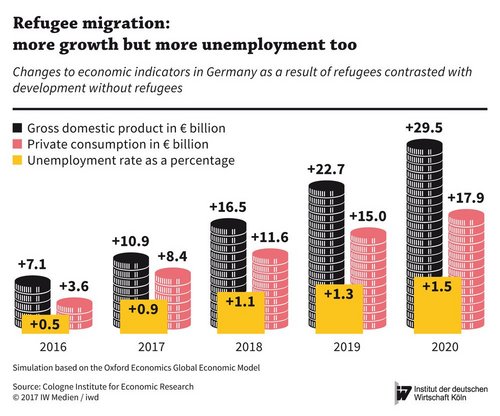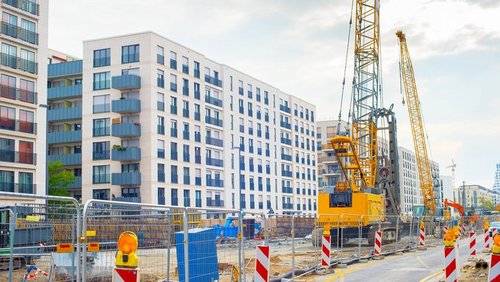Refugees: what happens when there is a sudden boost to a country's population? Will Germany’s acceptance of millions of refugees cost it dearly in the medium term or will it prove to be economically advantageous? This depends mostly on one thing: how well the immigrants integrate on the domestic labour market.

Migration as a Growth Factor
Over the past two years, around 1.2 million refugees have arrived in Germany – and some 90 per cent of those want to stay permanently. Since the Balkan route was closed in the spring of 2016, only between 15,000 and 20,000 people have sought asylum in Germany each month, meaning an additional 200,000 refugees are now expected each year. On top of this, many of them have relatives who are allowed to join under family reunification arrangements. Statistically speaking, every person with refugee status is followed by 0.8-1.2 family members, so by the year 2020 it can be expected that a further 700,000 people from war and crisis hit regions will have arrived in the Federal Republic of Germany.
These people all need a roof over their heads, a livelihood – and above all, economic prospects. After all, every economically inactive refugee costs the state around €12,000 per year for accommodation and basic needs alone. Then there is expenditure for language and integration courses, schooling, vocational education and training, and for public investment – in housing construction, for example. The costs of healthcare are also rising due to the refugees. Based on present immigration figures and assuming that 20 per cent of refugees of working age find employment in the short term, the state has significant costs to meet, as a simulation by Cologne Institute for Economic Research (IW) shows (see graph).
Germany had to spend almost €18 billion last year on the refugees who arrived in the country during 2015 and 2016.
Furthermore, over the course of the next few years, state spending on refugees’ basic needs will rise steadily – even if a further 10 per cent find paid work within a maximum of 12 months and a further 5 per cent by the end of each subsequent 12-month period. So, based on the assumption that in four years’ time half of the refugees of working age who arrived in 2015 have found employment, the bill will be as follows.
In 2020, a sum of more than €28 billion is likely to be needed for accepting and integrating refugees.
Though increased expenditure weighs upon the state budget, it simultaneously boosts the growth of an economy – because, for example, additional teachers will have to be employed and new housing built. Also, those refugees who find work or set up their own business will contribute to an increase in gross domestic product (GDP).
The impact of refugee migration on total economic output in Germany will increase gradually over time (see graph):
While GDP rose by around €7 billion as a result of refugees in 2016, this increase could be approaching €30 billion in 2020.
This means that German gross domestic product would be 1 per cent higher than it would have been if Germany had not accepted and integrated the refugees. The bottom line is that support for refugees will contribute a total of almost €90 billion to economic growth in Germany between 2016 and 2020. During this period, only €37 billion will flow into state coffers, because of higher VAT receipts generated by the private consumption of refugees as well as the tax and social security contributions paid by those refugees who are in paid work.
Although the economy as a whole will grow due to the inflows in refugees, economic output per inhabitant will decrease. This is partly because of the fact that the refugees lack qualifications – every fourth or fifth has only attended primary school or has not attended school at all. On the other hand, the economic output per inhabitant falls because far fewer refugees are in work compared with Germany's existing population.
Due to inflows of refugees, real GDP per capita in Germany dropped by almost €400 in 2016; by 2020, it will be almost €800 lower.
The fact that this effect will intensify over time can be attributed, among other things, to family reunification: family members joining refugees in Germany – usually the spouse and children of recognised asylum seekers – are usually even more unlikely to be economically active than the family members who sought asylum in Germany in the first place. Furthermore, growth effects from additional state expenditure will fall after 2016.
There will also be an impact on the labour market. By 2020, the unemployment rate is likely to rise by 1.5 percentage points, due to immigration.
According to estimates by IW, the state will spend more on refugees than it receives from them over the coming years. However, in the long term there is certainly the possibility that the German economy will perform better than would have been the case without the inflows of refugees. The better refugees can become qualified and integrate, the more likely this is – since this is the only way they can find suitable work and thus contribute sustainably to an increase in economic output.
More on the topic

Effects of Public Investment on Companies in Germany – Results of the IW Business Survey
Weak public investment activity in Germany has contributed to the low productivity growth of the last decades. Even maintaining the contribution to growth of state-owned capital stock at the already low level of the 1990s would have required an additional ...
IW
Reform of EU-fiscal rules: Lindner's ideas have merit
The German government's proposal to introduce a fixed limit on government spending growth for highly indebted member states in the course of the reform of the Stability and Growth Pact makes sense. Given the macroeconomic environment, such a minimum ...
IW